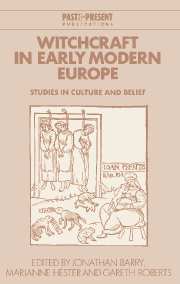Book contents
- Frontmatter
- Contents
- Preface
- Contributors
- 1 Introduction: Keith Thomas and the problem of witchcraft
- PART 1 THE CRIME AND ITS HISTORY
- 2 ‘Many reasons why’: witchcraft and the problem of multiple explanation
- 3 Witchcraft studies in Austria, Germany and Switzerland
- 4 State-building and witch hunting in early modern Europe
- PART 2 WITCHCRAFT AND RELIGION
- PART 3 THE MAKING OF A WITCH
- PART 4 WITCHCRAFT AND THE SOCIAL ENVIRONMENT
- PART 5 DECLINE
- Index
- Past and Present Publications
2 - ‘Many reasons why’: witchcraft and the problem of multiple explanation
Published online by Cambridge University Press: 06 July 2010
- Frontmatter
- Contents
- Preface
- Contributors
- 1 Introduction: Keith Thomas and the problem of witchcraft
- PART 1 THE CRIME AND ITS HISTORY
- 2 ‘Many reasons why’: witchcraft and the problem of multiple explanation
- 3 Witchcraft studies in Austria, Germany and Switzerland
- 4 State-building and witch hunting in early modern Europe
- PART 2 WITCHCRAFT AND RELIGION
- PART 3 THE MAKING OF A WITCH
- PART 4 WITCHCRAFT AND THE SOCIAL ENVIRONMENT
- PART 5 DECLINE
- Index
- Past and Present Publications
Summary
It is a familiar paradox to claim that the more we know about any subject, the harder it becomes to generalise about it. The last twenty-five years have been a golden period for the historical study of witchcraft, transforming the subject from an esoteric byway into a regular concern of social, religious and intellectual historians. Valuable research has been carried out in virtually every country in Europe, and in the New World, enhancing our knowledge enormously in both depth and breadth. Hugh Trevor-Roper's pioneering essay, which did much to stimulate this interest, also reminds us how far we have travelled. The information available for a modern synthesis is greater by several orders of magnitude than that available to him around 1960. A wide range of interpretative strategies, drawing on virtually every kind of theoretical and interdisciplinary approach, has been brought to bear on the phenomenon. We certainly understand far more about the inner logic of both beliefs and persecution than our predecessors. Yet it is apparent that no kind of definitive interpretation has emerged; if in some ways this is comforting for those still working on witchcraft, it is also somewhat daunting. Whatever the attractions of knowing that a mystery remains unsolved, one would prefer to have something more than ever-increasing complexity to claim as a result of one's efforts. It does seem at least possible that the strongly empirical bias of most historians has contributed to this situation, and that the wood is at times being lost for the trees.
- Type
- Chapter
- Information
- Witchcraft in Early Modern EuropeStudies in Culture and Belief, pp. 49 - 63Publisher: Cambridge University PressPrint publication year: 1996
- 11
- Cited by



